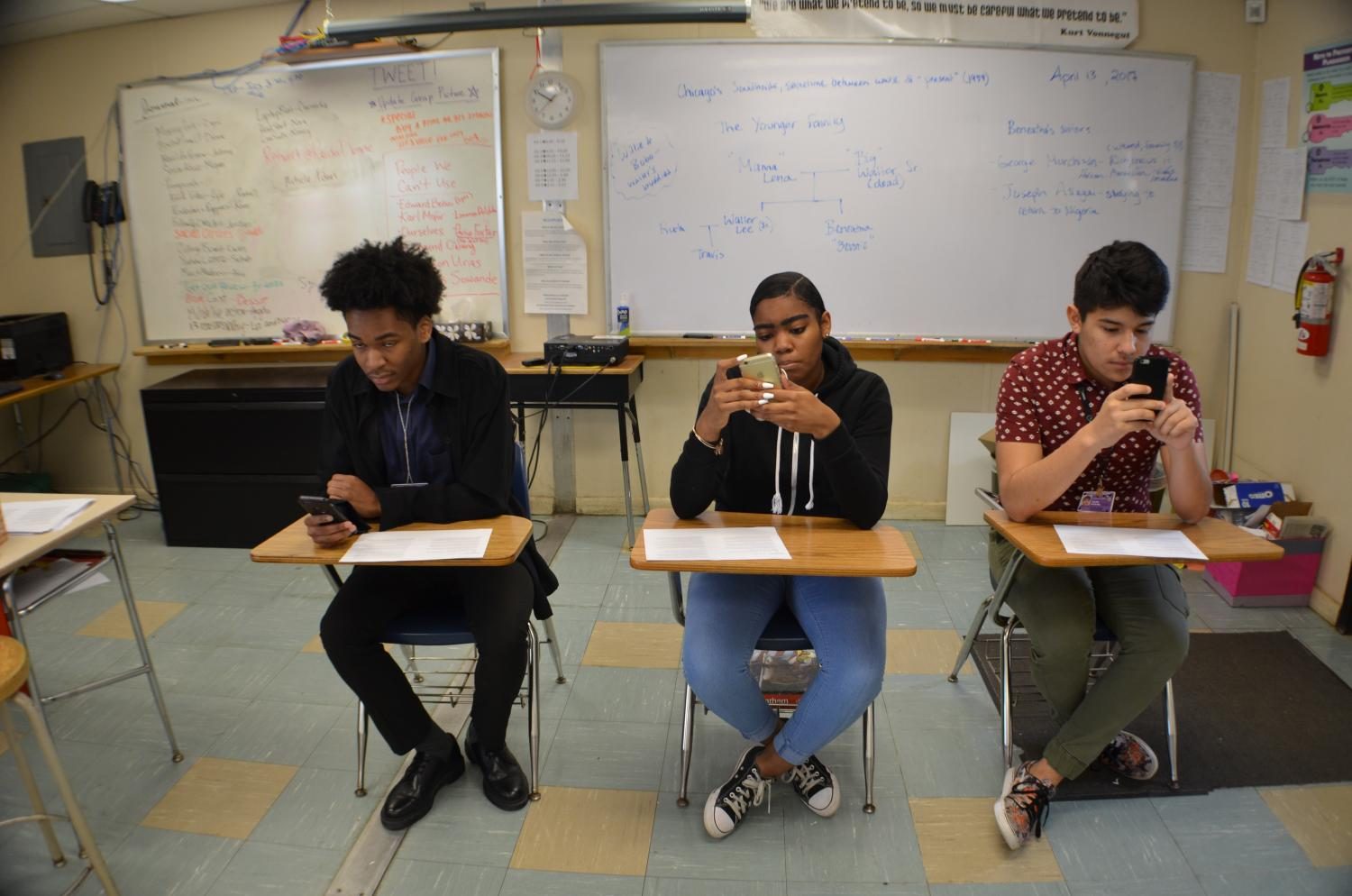Tech Check: How Do You Use Your Phone?
A staged demonstration of ERHS students using their phones.
May 8, 2017
Over the past decade, technology has vigorously changed the way we interact and communicate with others. It has allowed us to share information with whomever we desire, within the blink of an eye. Our society has shifted from the Industrial to the Information Age, a “digital” period in human history where information that we seek or desire is only a click away. As a result, millennials, and the generations following them, are becoming a more informed population. With the widespread distribution of smartphones, a culture that includes tweeting, vlogging, snapchatting, and livestreaming has smoothly integrated itself into society. Cell phones have even integrated themselves into the classroom, with teachers incorporating them into their everyday curriculum. But when does the use of cell phones pose a harm to a student’s education or well being? How can an electronic device that we use everyday for productivity and entertainment be a bad thing?
Cheating: “All you gotta do is pull out your phone and look it up,” said freshman Allen Dalton when referring to how easy it was to cheat on an assignment. With the use of smartphones, cheating has become easier. With just a simple click of the camera button, a student can photograph their work and distribute it to others. By doing that, students have become dependent on others for their work and cheat themselves out of learning the material. Classwork and homework are essential for understanding what’s being taught, and by simply copying the work of others, the student is really cheating themselves out of doing well on quizzes and final exams. Cheating does not only hurt the chances of a student excelling at exams, but it hurts the integrity the student knowingly promised to keep. There is a “moral code” expected to be kept between teacher and student: To devote a good faith effort to all work assigned. But the moment a student pulls out a phone to cheat on a homework assignment, or even a test, that code is broken, along with the trust between said teacher and student. The consequences that follow getting caught are severe, such as a failing grade on the assignment or even in-school suspension. But the consequences of cheating in high school are exceedingly different from cheating at a collegiate level. When a college student is caught cheating, disciplinary actions can include class failure, suspension or expulsion, legal intervention, and permanent damage to a student’s academic career. So before pulling out your cell phone during a test, think to yourself: Is it really worth it?
Sexual Exploitation: Smartphones have made sharing media, such as photos and videos, effortlessly simple. However, smartphones have made sharing media with anyone and everyone possible. With applications such as AirDrop, iCloud Photo Sharing, and iMessage, sharing private information with someone could become a public issue very quickly. With these applications, a person could intentionally distribute screenshots of a personal text message, nude photographs, or, if the victim is a minor, child pornography. According to maryland-criminallawyer.com, it is a crime for anyone to be in possession of an image or video of a child under the age of consent (16) engaging in sexual activity, or being in the state of sexual excitement. Penalties include up to 5 years of imprisonment and/or a fine of up $2,500 for a first offense, or up to 10 years of imprisonment and/or a fine as high as $10,000 for repeated offenders. Anyone who produces or aids in the distribution of child pornography faces up to 10 years in prison and/or a fine of up to $25,000. Successive convictions can lead to a sentencing of at least 20 years, and/or a fine of up to $50,000. With these facts, what solution can we devise to ensure that the use of cell phones does not lead to a felony? Senior Jazmyn Berry said there “should be some regulation on cell phones due to how it can emotionally damage another student.”
Cyberbullying: A generation ago, the term “cyberbullying” had not even come into existence yet. Now, with internet accessibility increasing and the flourishing of cell phones, students have found a new way to bully one another: Through a screen. Now, unkind words can be exchanged through a social media space such as Twitter or Instagram, text messaging, or email. But how is cyberbullying different from other types of bullying? For one, cyberbullying can happen at any time of day, as frequently as possible. It can reach the victim even when the victim is alone, causing the victim to feel vulnerable at all times. Cyberbullying can also be posted anonymously, making it hard to trace the source of the attack.
Senior Katelyn Vandyke noted this, saying that cyberbullying has become more prevalent, due to “the use of anonymous apps causing the bully to not get in trouble and remain anonymous.”
Messages, images, and videos can be shared very quickly to a widespread audience, which can be hard to control. Finally, deleting harassing material off the internet can be extremely difficult, especially if it has already been posted or sent by many people. Bullying/cyberbullying has been proven to lead to or worsen feelings of isolation, depression, and anxiety, emotions that can be associated with suicide. According to a study done by The New York Times, U.S. suicide rates have reached their highest level in 30 years, with increases in every age group except 75 years of age and above. With the facts presented, it is essential that students think about how their words, typed or not, can affect another’s life.




